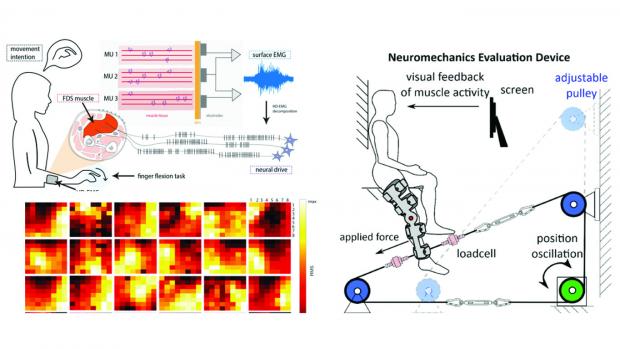Delaying rehabilitation services can be devastating for stroke patients; Professor S. Farokh Atashzar is finding solutions

Top-left: A high-density electromyography (HD-EMG) recording schematic starting from intention of motion, resulting in the generation of neural drive which can be picked up by the densely located EMG sensor matrix. Bottom-Left: A sample of 8x8 HD-EMG recording over different tasks to be decomposed using deep recurrent neural network into motor unit action potential with the motivation of high spatiotemporal resolution for the control of active prosthetic system; Right: an exoskeleton Robotic system to be used for identifying the energetic behavior of human hip joint to maximize agility.
Assistant Professor S. Farokh Atashzar, who is jointly appointed to the Department of Electrical and Computer Engineering and the Department of Mechanical and Aerospace Engineering, is deeply involved in solving a pressing and timely problem.
The incidence rate of age-related neuromuscular disorders and movement disabilities is rapidly increasing worldwide due to our aging society, and stroke is among the leading causes. There are now more than six million stroke survivors living in the United States alone, and many of them require labor-intensive kinesthetic rehabilitation services for extended periods. There is also an increasing concern about COVID19-related strokes, which would potentially affect the statistics due to the widespread nature of the pandemic.
In addition, the capacity of the healthcare system is currently focused on managing the COVID-19 pandemic, a situation that is resulting in delays in delivering rehabilitation services to patients in need. However, the chance of recovery is at its maximum right after the stroke and diminishes sharply when time passes, calling for very early rehabilitation and mobilization.
Atashzar explains that in recent years, the topic of robotic neurorehabilitation has attracted a great deal of interest because it can significantly reduce the load on healthcare systems and accelerate the rehabilitation process. Telerobotic rehabilitation is the next natural extension of the current technology, causing even more of a buzz since patients can receive an immersive, personalized experience regardless of their geographical and accessibility limitations, and possibly at their homes. While the technology has not been used on a large scale yet, the COVID-19 crisis brought the need for telehealth services of all types into sharp focus.
Atashzar points out that telerobotic rehabilitation was not possible in the past, in part, because of concerns about the reliability and resiliency of the network and security of data transfers. Latency, jitter, and packet loss can not only deteriorate the fidelity of information rendering, it can also result in a phenomenon called “non-passive network coupling,” meaning an exponential energy accumulation at ports of the telerobotic communication occur, potentially resulting in the asynchronous out-of-control behavior of the coupled robotic systems. When the two multimodal robotic modules (one at the patient’s side and the other at the therapist’s side) are coupled through a network, degraded quality of service can even result in significant safety concerns.
This calls for the design and implementation of novel control architectures to provide safe remote sensorimotor rehabilitation, and Atashzar has proposed novel passivity-based and small-gain-based stabilizers to address the stability issue while maximizing the performance and transparency of force-motion coupling between remote therapists and their patients.
The papers to prove it
Atashzar, in collaboration with his colleagues in Canada and the U.K., has recently published several papers on their wide-ranging research into robotic rehabilitation and telemedicine. These include:
- “Energetic Passivity Decoding of Human Hip Joint for Physical Human-Robot Interaction,” whichdiscusses ways of maximizing the performance of wearable exoskeletons
- "Towards Universal Neural Interfaces for Daily Use: Decoding the Neural Drive to Muscles Generalises Highly Accurate Finger Task Identification Across Humans,"; which discusses how peripheral neural signals can better be used to estimate movement-specific muscle activation patterns for the purpose of human-machine interfacing.
- “Parallel Haptic Rendering for Orthopedic Surgery Simulators,” which introduces a haptic rendering algorithm for simulating surgical bone machining operations that could result in higher realism in simulating orthopedic procedures.
- “Wearable Multichannel Haptic Device for Encoding Proprioception in the Upper Limb,” which describes the design, implementation, and evaluation of a wearable multichannel haptic system that aids wearers of upper-limb prosthetics.
- “Deep Learning for Robust Decomposition of High-Density Surface EMG Signals,” which explores pairing high-density surface electromyography signals and blind source separation output to train a model to predict motor unit activations within a supervised learning framework.
- “Adaptive Spatial Filtering of High-Density EMG for Reducing the Influence of Noise and Artefacts in Myoelectric Control,” which was chosen to be featured in IEEE Transactions on Neural Systems and Rehabilitation Engineering this July.
Ushering in a new age of medical care
Atashzar also recently had the honor of editing a special issue on “Robotics, Autonomous Systems and AI for Nonurgent/Nonemergent Healthcare Delivery During and After the COVID-19 Pandemic” that will appear jointly with the journals Frontiers in Robotics and AI, Frontiers in Big Data, Frontiers in Artificial Intelligence, and Frontiers in Neurorobotics. The issue will include numerous articles from researchers around the world on topics related to robotic autonomy and machine intelligence for enhancing healthcare delivery during a pandemic, with the goal of understanding the existing challenges, potential solutions, and future vision for the benefits offered by robotics, automation and AI for healthcare delivery.
“In times of a health crisis such as the novel coronavirus pandemic, medical robotic systems, autonomous agents, and AI technologies can play a significant role by augmenting and assisting the healthcare system and safeguarding public health in various ways,” Atashzar says. “The aforementioned technologies can facilitate the prevention, containment and mitigation of the coronavirus disease and provide general support for patients and medical professionals, alleviating the burden placed on healthcare systems during this crisis. My co-editors and I hope that this special issue will provide an overview of the exciting work going on in our field. The practical applications promise to improve the health and well-being of countless people and usher in a new age of medical care.”





